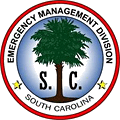- ▾ Other ShakeOuts ▾
- Alaska
- American Samoa
- Arizona
- British Columbia
- California
- Central U.S. (AL AR IA IL IN KS KY LA MO MS NE OH OK TN)
- CNMI
- Colorado
- Guam
- Hawaii
- Idaho
- Japan
- Montana
- Nevada
- New Mexico
- New Zealand
- NorthEast U.S. (CT MA ME NH NJ NY PA RI VT)
- Oregon
- Puerto Rico
- Quebec & Eastern Ontario
- SouthEast U.S. (DC DE FL GA MD NC SC VA WV)
- Texas
- Upper MidWest U.S. (MI MN ND SD WI)
- U.S. Virgin Islands
- Utah
- Washington State
- Wyoming
- Yukon
- Other Countries

South Carolina
The Great Central U.S. ShakeOut is a nine-state drill spanning much of the central United States. This page has information for participants living in South Carolina. ShakeOut activities for South Carolina are supported by the South Carolina Emergency Management Division (SCEMD). For more information on ShakeOut activities in South Carolina, you can contact your State Earthquake Program Manager, State Public Information Officers, or FEMA Regional Earthquake Program Manager.
State Earthquake Program Manager
Tammie Dreher, SCEMD
Email: tldreher@emd.sc.gov
State Public Information Officers
Joe Farmer and Derrec Becker, SCEMD
Email: jrfarmer@emd.sc.gov, dbecker@emd.sc.gov
FEMA Regional Earthquake Program Manager
Gene Longenecker, FEMA Region IV
Email: herbert.longenecker@dhs.gov
Phone: (770) 220-5428
MARK YOUR CALENDAR!
2013 ShakeOut:
10:15 a.m. (Eastern) on February 7!
PARTICIPANTS
people are currently registered to participate in the 2013 ShakeOut Drill.
are from
South Carolina
Number of participants in each category
View names of
participants:
EARTHQUAKE HAZARDS
While South Carolina is usually not known for earthquakes, ten to thirty earthquakes are recorded annually and two to five earthquakes are felt each year. These earthquakes tend to be less than magnitude 3.0 on the magnitude scale and cause little damage.
Most of South Carolina’s earthquakes occur in the Coastal Plain where the underlying rocks are very faulted or broken from the break-up of the plates. These cracks in the deep rocks mean that this area of the plate is weak. If pressure is exerted on the edge of the plate, some of these faults/breaks will allow the rocks to move. Faults in South Carolina have been mapped and estimated. Fault rupture is not the only cause of earthquakes. Small earthquakes may also occur near dams from water pressure and near the Appalachian Mountains.
Currently, there is no reliable method for predicting the time, place, and size of an earthquake. Several areas of South Carolina regularly experience earthquakes and have experienced strong earthquakes in the past. Approximately 70% of all earthquakes in the state occur in the Coastal Plain with most clustered around three areas of the State: Ravenel-Adams Run-Hollywood, Middleton-Place-Summerville, and Bowman. There is a consensus among seismologists that where earthquakes have occurred before, they can again.
On August 31, 1886 Charleston, South Carolina, experienced the most damaging earthquake in the eastern United States. The initial shock lasted nearly one minute. The earthquake had a magnitude of 7.3 (Johnson, 1996) and was felt over 2.5 million square miles, from Cuba to New York, and Bermuda to the Mississippi River. Structural damage extended several hundred miles to cities in Alabama, Ohio, and Kentucky. At the time of the earthquake, many of the residents of Charleston thought it was a calamity that struck the entire world. Many residents were surprised when they discovered it was principally their area where the majority of severe damage occurred.
Geologically, Charleston lies in one of the most seismically active areas in the Eastern United States. The seismicity in the Coastal Plain of South Carolina clusters around the cities of Summerville and Bowman, SC, known as the Middleton Place - Summerville Seismic Zone (MPSSZ).
Currently the MPSSZ experiences between 10 to 15 magnitude 3 or less events every year. Large events, like the 1886 earthquake, have been recorded in the oral history of the area (~1600 and 13-1400's AD). Additionally, paleoseismic investigations have shown evidence for several pre-historic, liquefaction-inducing earthquakes in coastal South Carolina in the last 6000 years. If the present is the key to the past, and the past is an analog for the future, then the Charleston region can expect to experience another 1886 magnitude event in the future.
Information Source South Carolina Emergency Management Division:
http://www.scemd.org/News/publications/EQ%20Guide%202008/Cover_EQ_08.html
Please follow us on:
www.facebook.com/scemd
www.twitter.com/emdsc
www.youtube.com/TheSCEMD
This section will be updated with more detailed hazard information for this area. For now, the following links provide local and statewide earthquake hazard information:
State Emergency Management Website
http://www.scemd.org/
SC Earthquake Education and Preparedness Program (SCEEP)
http://scearthquakes.cofc.edu/
SC Seismic Network (SCN)
http://www.seis.sc.edu/projects/SCSN
State Geological Survey Website
http://www.dnr.sc.gov/geology/
USGS State Earthquake Website
http://earthquake.usgs.gov/earthquakes/states/index.php?regionID=40






